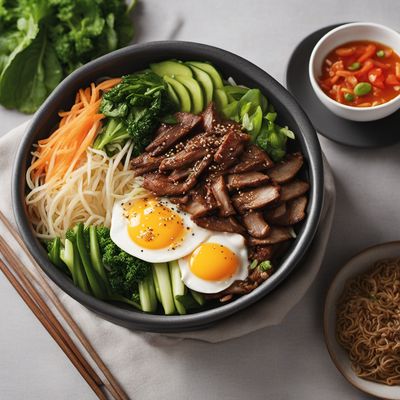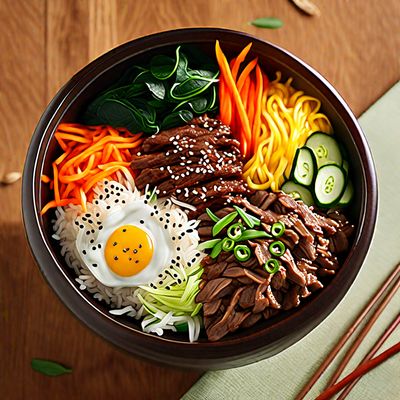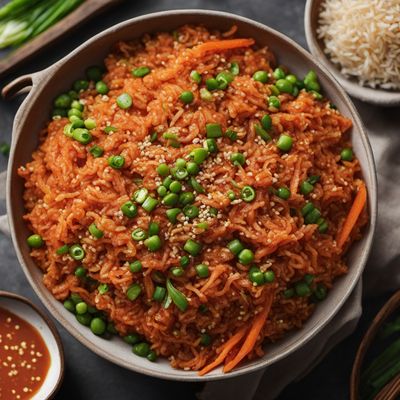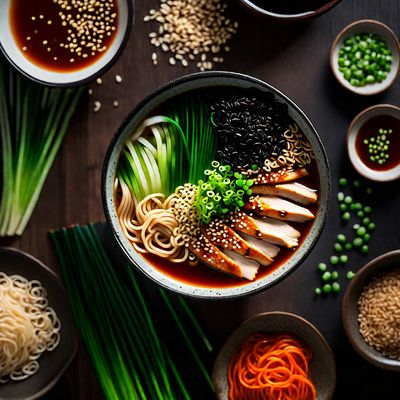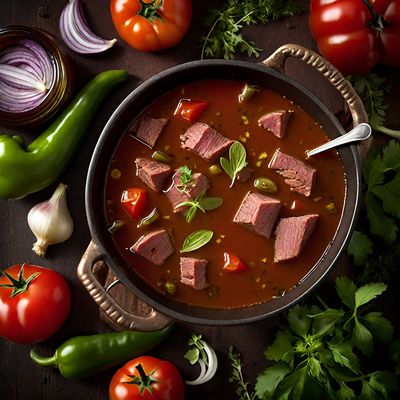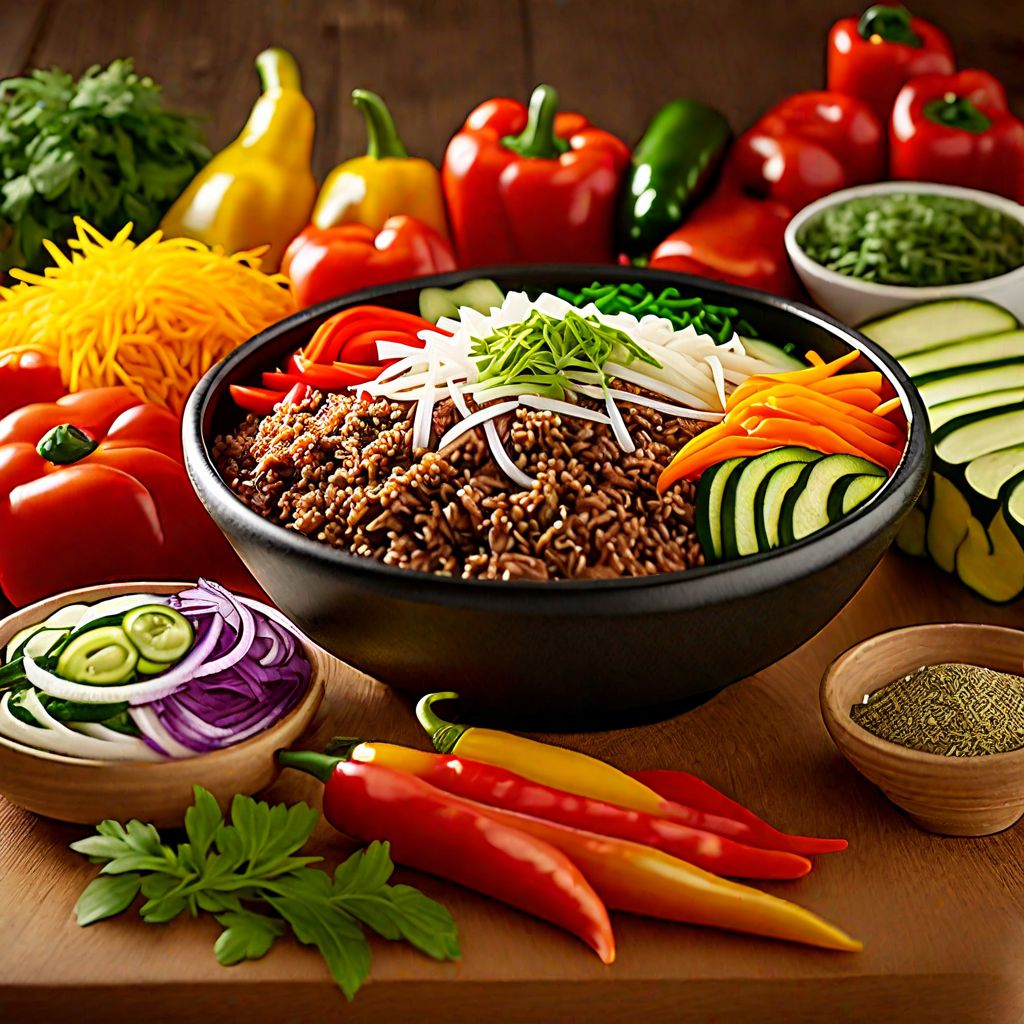
Recipe
Turkish-style Bibimbap
Istanbul Delight: Turkish-inspired Bibimbap
4.8 out of 5
In the vibrant world of Turkish cuisine, we bring you a delightful twist on the classic Korean dish, Bibimbap. Turkish-style Bibimbap combines the rich flavors of Turkish ingredients with the colorful presentation of Bibimbap. This fusion dish is a true celebration of the culinary arts, blending the best of both cultures into a harmonious and satisfying meal.
Metadata
Preparation time
30 minutes
Cooking time
30 minutes
Total time
60 minutes
Yields
4 servings
Preparation difficulty
Medium
Suitable for
Vegetarian, Gluten-free (if using gluten-free bulgur), High-protein, Low-fat, Balanced diet
Allergens
Wheat (if using regular bulgur), Dairy (if using yogurt)
Not suitable for
Vegan, Dairy-free, Paleo, Keto, Low-carb
Ingredients
While the original Korean Bibimbap traditionally uses gochujang sauce and kimchi, our Turkish-style Bibimbap incorporates Turkish spices and ingredients such as sumac, Aleppo pepper, and yogurt. We also substitute the Korean rice with bulgur, a staple grain in Turkish cuisine. These adaptations infuse the dish with a unique Turkish flair while maintaining the essence of Bibimbap. We alse have the original recipe for Bibimbap, so you can check it out.
-
1 cup (200g) bulgur 1 cup (200g) bulgur
-
2 cups (470ml) water 2 cups (470ml) water
-
2 tablespoons olive oil 2 tablespoons olive oil
-
1 onion, thinly sliced 1 onion, thinly sliced
-
2 cloves garlic, minced 2 cloves garlic, minced
-
1 red bell pepper, thinly sliced 1 red bell pepper, thinly sliced
-
1 zucchini, thinly sliced 1 zucchini, thinly sliced
-
1 carrot, julienned 1 carrot, julienned
-
200g ground beef 200g ground beef
-
2 tablespoons tomato paste 2 tablespoons tomato paste
-
1 teaspoon sumac 1 teaspoon sumac
-
1 teaspoon Aleppo pepper 1 teaspoon Aleppo pepper
-
Salt and pepper, to taste Salt and pepper, to taste
-
4 eggs 4 eggs
-
1 cup (240g) plain yogurt 1 cup (240g) plain yogurt
-
Fresh parsley, chopped (for garnish) Fresh parsley, chopped (for garnish)
Nutrition
- Calories (kcal / KJ): 400 kcal / 1674 KJ
- Fat: 12g / 5g saturated
- Carbohydrates: 50g / 8g sugars
- Protein: 25g
- Fiber: 10g
- Salt: 1g
Preparation
-
1.In a saucepan, bring the water to a boil. Add the bulgur, cover, and simmer for 15-20 minutes until the bulgur is tender. Set aside.
-
2.Heat olive oil in a large skillet over medium heat. Add the onion and garlic, and sauté until translucent.
-
3.Add the red bell pepper, zucchini, and carrot to the skillet. Cook for 5-7 minutes until the vegetables are slightly softened.
-
4.Push the vegetables to one side of the skillet and add the ground beef. Cook until browned, breaking it up into small pieces.
-
5.Stir in the tomato paste, sumac, Aleppo pepper, salt, and pepper. Cook for an additional 2-3 minutes until well combined.
-
6.In a separate non-stick pan, fry the eggs to your desired doneness.
-
7.To assemble the Turkish-style Bibimbap, divide the cooked bulgur among serving bowls. Top with the sautéed vegetables and ground beef mixture. Place a fried egg on top of each bowl.
-
8.Serve the Turkish-style Bibimbap with a dollop of plain yogurt and a sprinkle of fresh parsley.
Treat your ingredients with care...
- Bulgur — Make sure to rinse the bulgur thoroughly before cooking to remove any impurities.
- Sumac — Use sumac sparingly as it has a tangy and slightly acidic flavor.
- Aleppo pepper — Adjust the amount of Aleppo pepper according to your spice preference.
- Yogurt — Choose a thick and creamy yogurt for a delicious topping.
Tips & Tricks
- For a vegetarian version, replace the ground beef with cooked chickpeas or tofu.
- Customize your Turkish-style Bibimbap by adding additional toppings such as sliced cucumbers, olives, or roasted eggplant.
- Drizzle some olive oil and lemon juice over the dish for an extra burst of flavor.
- If you prefer a spicier Bibimbap, add a sprinkle of Turkish red pepper flakes.
- Experiment with different herbs and spices to create your own unique twist on this Turkish-inspired dish.
Serving advice
Serve the Turkish-style Bibimbap hot, allowing the flavors to meld together. Mix all the ingredients in the bowl before enjoying each delicious bite.
Presentation advice
Present the Turkish-style Bibimbap in individual bowls, with the vibrant colors of the vegetables and the sunny-side-up egg on top. Garnish with a sprinkle of fresh parsley for a pop of green.
More recipes...
For Bibimbap » Browse all
For Korean cuisine » Browse all
More Korean cuisine dishes » Browse all

Patbingsu
Patbingsu is a traditional Korean dessert that is made with shaved ice, sweet red bean paste, and other toppings. It is a refreshing and sweet...

Gim gui
Roasted Seaweed
Gim gui is a Korean dish made from grilled seaweed.

Yukgaejang
Spicy beef soup
Yukgaejang is a spicy Korean soup made with beef, vegetables, and chili paste. It is a popular dish that is enjoyed by people of all ages.
